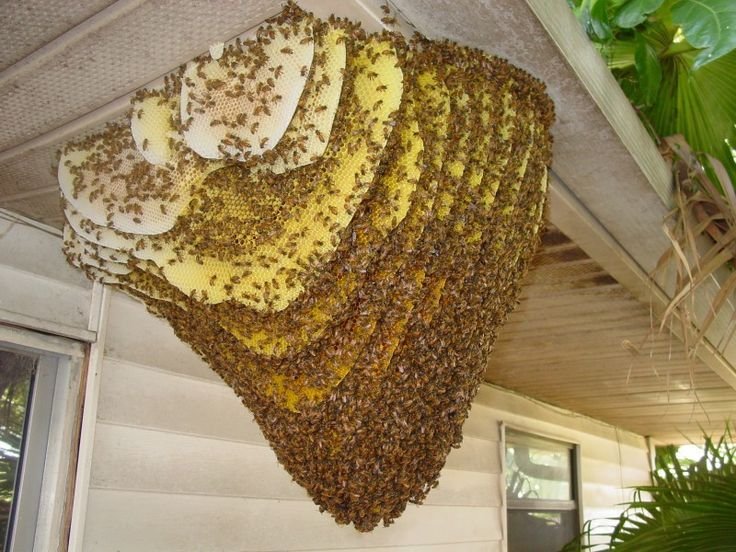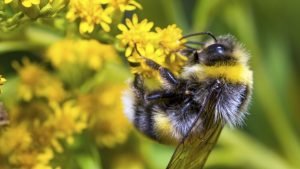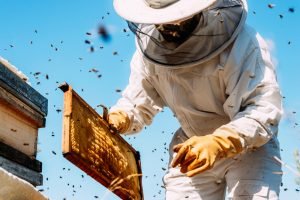Humane Honey Bee: Removal & Relocation

How To Identify Honey Bees?
If a property owner suspects a honey bee colony has infiltrated a structure’s wall, he or she should confirm the insects are honey bees. Carpenter bees, yellow jackets, and European hornets are examples of insects that could infiltrate a structure’s wall. Honey bees are smaller than carpenter bees and range in color from yellow to black. They have black or brown bands across their abdomen and are much smaller than carpenter bees. Honey bees, on average, are 2/3 of an inch long and have setae, or hair, covering their bodies. Pollen baskets on each hind leg of foraging honey bees are frequently loaded with a ball of yellow or dark green pollen.
Orange, white, or yellow hairs on the thorax and a black shiny abdomen on the dorsal side distinguish the carpenter bee. Carpenter bees are large, heavy-bodied bees that range in length from 3/4 to 1 inch. On exterior wooden surfaces, these insects bore half-inch wide holes that appear to be perfectly round.
Yellowjackets don’t have the dense body hair that carpenter bees and honey bees have. The hind legs on yellowjackets don’t have pollen baskets. The abdomen of the yellow jacket is characterized by alternating yellow and black bands and is about.5 inches long.
Why Are Bees Important?
To feed the world’s growing population, we need more food, which must be diverse, balanced, and of high quality to ensure humanity’s progress and well-being. Bees are well-known for producing high-quality food (honey, royal jelly, and pollen) and other products used in healthcare and other industries (beeswax, propolis, honey bee venom).
The pollination of nearly three-quarters of the plants that produce 90% of the world’s food is the most significant contribution of bees and other pollinators. Pollination is responsible for a third of the world’s food production, or every third spoonful of food.
Economic & Agricultural Importanace

The number of pollinator-dependent crops (fruit, vegetables, seeds, nuts, and oilseeds) has tripled in the last 50 years. In the context of agricultural production, bees play a critical role. Pollination increases the number of agricultural products produced, improves the quality of that product, and improves plants’ pest resistance.
Farmers, particularly smaller farmers and family-owned farms in developing countries, rely on pollinated plants for a significant portion of their income. Millions of people rely on them for work and income.
Honey Bee Importance To The Environment
Bees are essential for maintaining ecological balance and biodiversity in the natural world. They perform one of the most well-known ecosystem services: pollination, which is necessary for food production. They contribute to genetic and biotic diversity by protecting and maintaining ecosystems and animal and plant species.
Bees can also be used to gauge the state of the environment. Their presence, absence, or quantity alert us when something is wrong with the environment, and we need to take action.
What Damage Is Caused By Honey Bees?
A large bee colony’s weight alone can cause structural damage to your home’s walls, chimneys, and roofs. Honey, melting wax, and waste products can push through walls as hives expand, leaving damaging stains on painted and wallpapered surfaces. Beehives have a strong odor that attracts rodents and insects as well as other pests. When a nest becomes too crowded for the bees, they split up and relocate to the nearest available space. Honeybees can fill cavities from the ceiling to the floor and from wall stud to wall stud if left unattended.
What To Do When Honey Bees Have Invaded Your Property?

When dealing with stinging insects, it’s always best not to provoke them. The majority of bee species only sting if they believe their hive or queen is in danger. Keeping your distance reduces your chances of encountering an enraged hive. A swarm of bees will typically congregate around the queen on a branch, bush, or post. Avoiding this area should reduce your chances of being stung.
If the hive is inside your home, try to figure out how the bees got in. Blocking access to the hive, on the other hand, may result in the bees escaping into other areas of your home.
It’s tempting to try spraying the hive or catching the bees in a trap. Consider what could go wrong before you proceed. Bee eradication is difficult for various reasons, including the fact that the EPA has banned the use of many commonly sold bee insecticides. This means that using such products on bees is against the law.
Contact Animals Happen for certified beekeepers that can remove your bees humanely. A bee removal technician will conduct a survey and determine how the bees are entering your home. Afterward, the technician will advise on the best removal process and provide strategies to prevent future honey bee invasions.
The Honey Bee Removal Process
The bee removal process begins with the identification of a bee swarm on your property. Observe from afar and take note of what the insects look like and how many there are. Call Animals Happen, and we will send a bee removal expert to take a look at your property. Once a bee expert has arrived at your home, they will conduct a full inspection of the home. They will identify where the bees are, how they got inside, how many bees are present, and how much damage has occurred. The technician will present you with removal options and a timetable for the bee removal process.
The beekeeper is required to open the wall to remove the entire colony to remove the bees properly. If the exterior wall is brick, they’ll have to open it from the inside. The queen bee is then located and placed in a bee transportation comb. Most bees will follow the queen into the new comb, but there are always stragglers.
The leftover bees will be either scooped up and placed in the combs for transportation or sucked up in a bee-friendly vacuum. The vacuum allows removal technicians to gather together the bees and collect them for relocation safely.
After the bees have been removed, combs in the home can be removed, and the honey can be extracted for use or to feed other bees. The bee removal expert will wash the walls with ammonia or bleach after removing the comb to remove the pheromones the bees have left on the wood and in the wax left in the wood. The removal of these pheromones reduces the likelihood of the bees returning to this wall. After that, the wall is replaced, and the hole through which the bees entered is sealed.
How Much Does Honey Bee Removal Cost?

The average cost of bee removal is $450, but it can cost anywhere from $200 to $1,500 or more. The most expensive type of infestation is structural, which necessitates the removal of walls. The carpentry costs that result can push the total price up to $2,000 or more. Contacting a wildlife removal professional is the best bet to remove the bees. Attempting to remove them on your own may result in additional damage and repair costs.
Who To Call For Honey Bee Removal Services?
Homeowners should always hire a humane and experienced bee removal expert since bees play such a vital role in our economy, ecosystem, and agriculture. Animals Happen’s bee experts will remove the bees, repair any damage, and relocate the bees to a safe area. Contact a trustworthy removal company that is looking out for both the homeowner and the wildlife it’s working with.
